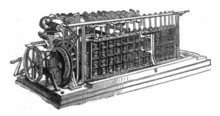Per Georg Scheutz

Pehr (Per) Georg Scheutz (23 September 1785 – 22 May 1873) was a 19th-century Swedish lawyer, translator, and inventor, who is now best known for his pioneering work in computer technology.
Life
Scheutz studied law at Lund University, graduating in 1805. He then worked as a legal expert and translator (he translated several works of William Shakespeare and Sir Walter Scott) before turning predominantly to liberal politics and mechanical engineering.
He is most known for his inventions; the best known of these is the Scheutzian calculation engine, invented in 1837 and finalized in 1843. This machine, which he constructed with his son Edvard Scheutz, was based on Charles Babbage's difference engine. An improved model, roughly the size of a piano, was created in 1853 and subsequently demonstrated at the World's Fair in Paris, 1855. The machine was then sold to the British government in 1859. Scheutz created yet another machine in 1860, selling it to the United States. The devices were used for creating logarithmic tables.
While the machine was not perfect and could not produce complete tables, Martin Wiberg reworked the construction from the ground up and in 1875 created a compact device which would print complete tables.
Scheutz was elected a member of the Royal Swedish Academy of Sciences in 1856.

See also
References
- Michael Lingren (1990). Glory and Failure: The Difference Engines of Johann Müller, Charles Babbage and Georg and Edvard Scheutz. MIT Press. ISBN 978-0-262-12146-0. Retrieved 27 April 2013.
- Mario G. Losano (ed.), Scheutz: La macchina alle differenze. Un secolo di calcolo automatico, Etas Libri, Milano 1974, pp. 164.